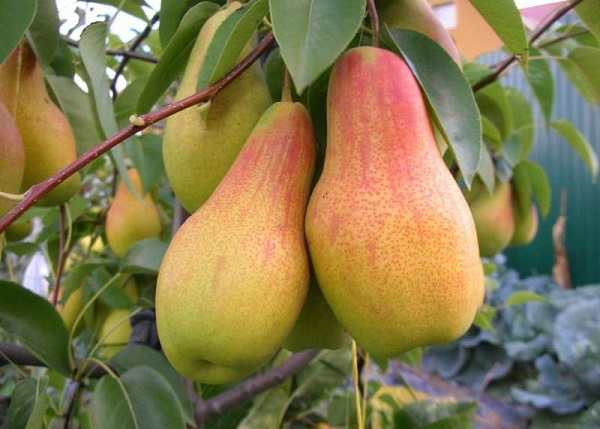What gardener does not grow pears? Its tasty fruits contain organic acids, fiber, pectic substances, vitamins, and therefore very useful. Among the huge diversity of species and varieties of pear Talgar beauty - one of the most popular.
Table of contents
Description varieties of pear Talgar beauty
Let's start with the description of the pear variety. Talgar beauty bred by AN. Katseiko, in the Kazakh Research Institute of Horticulture and Viticulture. The variety was obtained as a result of pollination of the seeds of the “Forest Beauty”. Breeding number 1-20 / 13.Since 1960, the variety has been in the state testing trials, and since 1991, the state register in the Kabardino-Balkarian Republic in the North Caucasus region is included. Today the plant is cultivated in Krasnodar and Stavropol Territory and in Ukraine.
Variety srednerosly, in height reaches about three meters. The crown is wide, dense, in the shape of a pyramid. The main branches grow almost perpendicular to the trunk, the fruits are tied mainly on annular branches. The bark is rough, gray. The shoots are medium thick, straight, brown. Buds are large in the form of a cone.
Leaves ellipsoid, with a pointed tip, rich green color, grow on long petioles. Fruits are large, with a bottle-shape characteristic of a pear and a smooth, dense skin. The average weight is 160 g, the largest ones reach 250 g. The color is pale yellow with a red blush. The flesh is juicy, fine-grained, crispy, with good taste.
The fruits ripen in early autumn, in late September and early October, you can store up to two months to extend the shelf life, you need to collect them ahead of time, so that the fruits were a little unripe.
The variety is early ripening, the first fruits are bearing for 4-5 years, the fruit is annual and very abundant. Talgar beauty is resistant to drought and frost, able to withstand temperatures up to -30 degrees. Even if it freezes, it recovers pretty quickly.
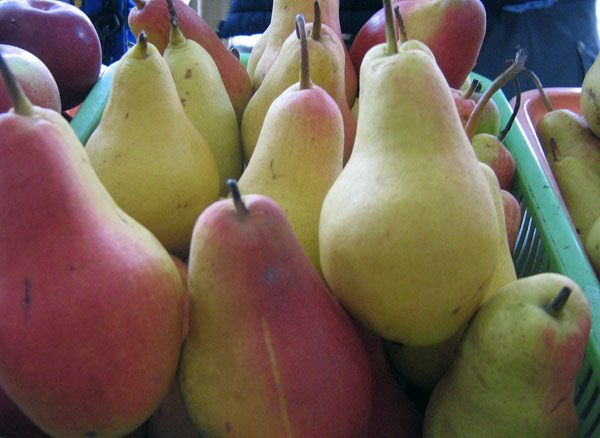
Due to this quality, it is suitable for growing in central Russia and Moscow region, but it grows best and bears fruit in the southern regions. In the northern regions is not cultivated.
Advantages and disadvantages
The main advantages of the variety are:
- unpretentiousness
- resistance to fungal diseases
- winter hardiness and drought resistance,
- large-yielding and high yield (up to 20 tons per 1 hectare),
- very good taste,
- fruits are well stored and tolerate transportation.
The disadvantages of the variety are minorThese include coarse fruit pulp, which is not suitable for lovers of soft pears and darkening of the pulp, if the fruit in time did not have time to remove.
Landing rules
For successful survival, it is best to acquire one-year-old seedlings, the height of their trunk from the root neck to the first branches should not exceed 60 cm, the length of the main branches should be about 5-10 cm, and the diameter of the trunk should be about 1 cm. The trunk should be healthy, without damage and disturbance integrity of the cortex.
The root system should be well developed, a tree with a small amount of fibrous roots and branches will be poorly acclimated. Before planting, the roots of the plant are immersed in water for a day, during which time they will gain moisture.
Pear loves fertile loose soil with a neutral or minimal acidity. Does not tolerate sandy, clay and marshy soil. If the groundwater lies above 2 m, then for planting trees need to make a mound.
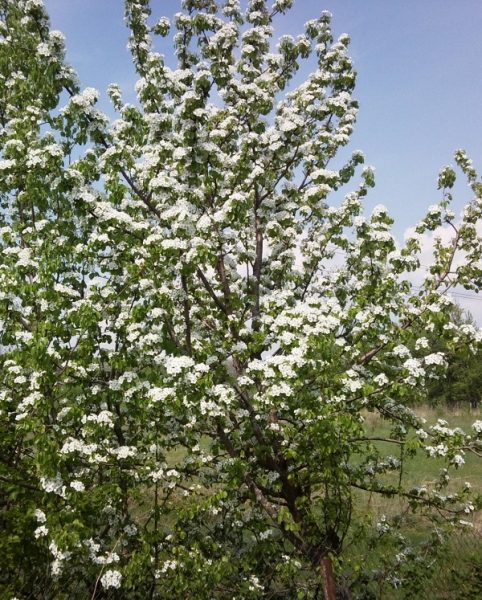
Landing stages:
- Preparation of the pit. A pit is dug a depth of at least 60 cm and a width of about half a meter. The soil is removed in layers: fertile top layer separately in one direction, and the bottom - in another.
- Fertilization. 3-4 buckets of humus or compost are added to the soil removed from the upper fertile layer; if the soil is acidic, 150-200 g of mineral phosphate fertilizers are applied.
- Part of the fertile soil with fertilizer poured into the center of the pit slide.
- A peg is driven into the center of the embankment, which will serve as a support for the tree and will help it to properly form the trunk.
- Landing. The prepared tree is lowered into a hole, gently straightening the roots along the hill and covered with fertile soil, so that the root neck is 4-5 cm above ground level. The ground is pounded with hands.
- Planted seedling tied with a rope to a peg.
After planting, the tree is watered with two or three buckets of water in an annular groove. To preserve moisture, the groove is milled with hay, sawdust, or dry grass.
Planting seedlings is best in early April, when it is already warm, but the buds have not yet blossomed. In the southern, warm regions, planting is carried out in the fall, when the leaves have fallen from the tree, but it is still far from frost. Also in the fall you can land and pear Augustus dew.
Growing rules
The main activities in the cultivation of pear trees:
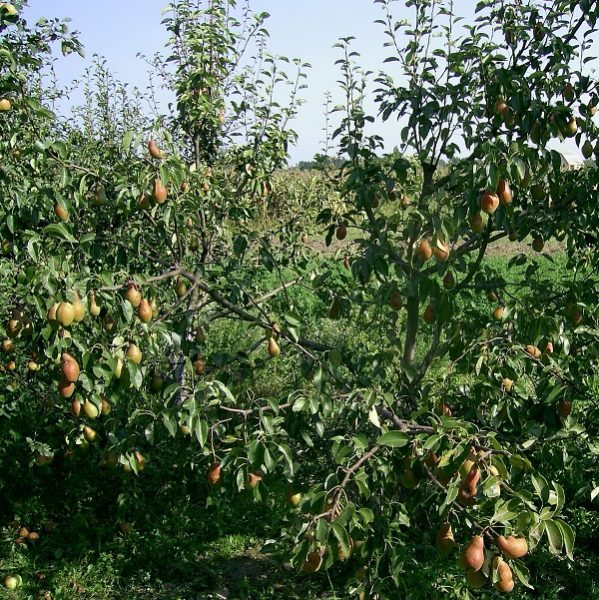
- Watering. As the soil dries around the seedling, it is watered at the rate of 2-3 buckets per tree. Adult plants are watered in June, during the period of active growth and in August, during the loading of the fruit. Water consumption per tree 25-30 buckets. Watering trees is best from the sprinkler.
- Mulching. Pristvolnuyu area each year covered with wood ash, peat or sawdust. In the summer, mulch prevents evaporation of moisture, and in winter serves as a heating pad.
- Feedings. In the spring, in the second year of planting, seedlings are fed with saltpeter (15 g per 1 m2). In the fall, a mixture of humus (5 kg), superphosphate (50g) and potassium salt (40 g) is introduced. For this, a trench is made around the trunk and fertilizer is mixed with the ground. Regardless of the stage of development of the tree, such dressings are carried out annually.
- Crop. From the second year of life the plant forms a crown. First, choose the most developed side branches that grow perpendicular to the stem, leave four of them, and the rest are cut. The branches are cut so that their ends are flush, and the center conductor towers 20-30 cm above them.After pruning, the cuts are treated with garden pitch. Trees pruned in early spring, before the movement of the juice.
- Harboring. Before frosts, the trunk of a young tree is treated with lime or special paint and insulated with agrofibre, cotton cloth or paper. This will protect the trunk from cold and rodents. In the spring, the whitewash is repeated to protect the plant from sunburn and parasites.
- Protection. For the prevention of diseases and repelling pests, a pear is sprayed every year with a 3% solution of Bordeaux mixture or iron vitriol.
Features grade
This variety is distinguished by unpretentiousness, endurance and very abundant fruiting, which grows every year as the tree grows older. Mature fruits are not showered and are able to stay on the branches even with strong wind.
For stable yield Talgan beauty requires cross-pollination. As pollinators, she would be suitable for the Goverla, Conference and Pet Klapp varieties.
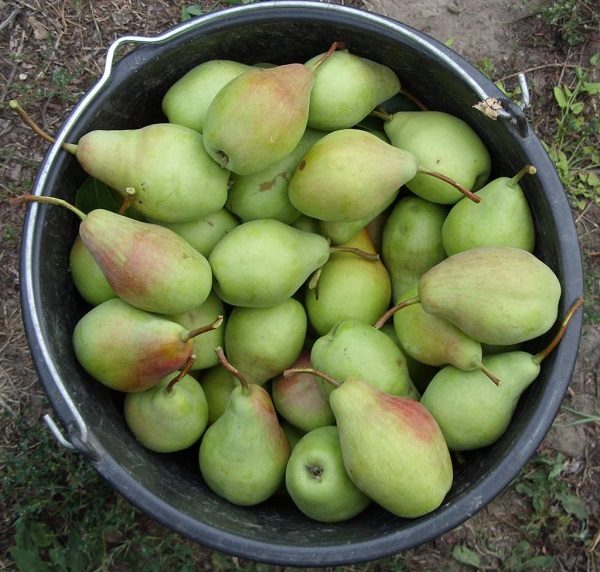
For better resistance to frost, this variety can be grafted on a forest pear, in addition, it has very good compatibility with quince rootstocks.
Diseases and pests
Despite the fact that the variety is very resistant to diseases, in order to prevent it, every year the tree is sprayed with fungicides and insecticides to protect against the suckling, pear gall mite and goldtail. With the same purpose using infusions of nettle, calendula and chamomile.
When infected with fruit rot, the affected fruits are removed and destroyed, and the tree is treated with 1% Bordeaux liquid or 4% solution of copper oxychloride.
For 10 liters of water, 25 g of the drug are taken and the resulting solution is sprayed on the tree until it is completely cured once a week.
Talgar beauty is a unique variety, the advantages of which largely prevail over disadvantages. It will be a worthy addition and even decoration of any garden!
